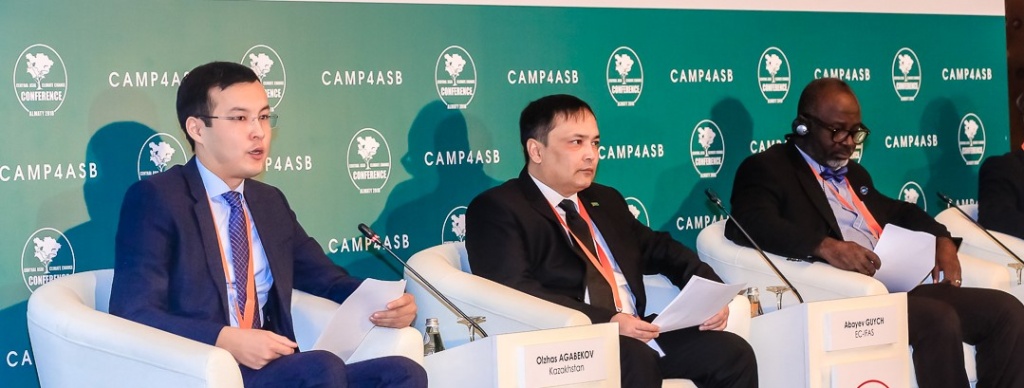Part I
What is climate change and what is its threat?
Climate change and global warming are the well-worn terms in the language of professionals in the climate change field, environmentalists, yet, unfortunately, not rooted in the consciousness of the population. Let's first determine what climate change is.
Definition of the Intergovernmental Panel on Climate Change (IPCC):
Climate change is a change caused directly or indirectly by a human being's activity, changing the global atmosphere composition, and which is complementary to the natural climate variability observed at comparable times.
Climate change’s main consequences are: changes in the global temperature and precipitation, increased risks of natural disasters, reduced water flow, melting glaciers, declining agricultural productivity, changing conditions in many sectors of economy and people’s living conditions. Water resources, biodiversity, forestry, land resources, agriculture, energy, tourism, and public health are the most vulnerable to climate change.
One of the main indicators used to assess the human influence on the climate change process is the carbon dioxide (C02) level in the atmosphere. According to the UN Secretary-General Antonio Guterres: "To date, the level of carbon dioxide is higher than it has been in the past 800,000 years."
Why is carbon dioxide so dangerous?
Increase in the carbon dioxide (CO2) concentration in the atmosphere is mainly linked to the active burning of fossil fuels by human beings. CO2, along with other greenhouse gases, is the cause of heat retention; they do not allow it to escape into the atmosphere. As a result, a greenhouse effect is created[1]. Climate change poses a serious threat to the entire planet. The countries of Central Asia are certainly not an exception, especially with respect to changes in water and agricultural sectors.
The need to climate change adaptation was acknowledged at the Climate Change Conference in Cancún, Mexico in 2010 and there were a number of key decisions for consolidating the international community efforts in this direction.
Adaptation to climate change is adjustments in the natural and anthropogenic systems in response to the actual or expected climate effects or its outcomes, which allows reducing harm or exploiting favourable opportunities. (Source: IPCC)
Adaptation measures implementation was further enhanced by the Paris Agreement ratification.
The Paris Agreement is an agreement under the United Nations Framework Convention on Climate Change which includes climate change adaptation and climate agreement measures. The Agreement was adopted during the Climate Conference in Paris, December 12, 2015, and signed on April 22, 2016.
The Paris Agreement member countries have the following tasks:
● Not to let the global average temperature to rise more than 2 degrees. Many scientists believe that a higher temperature increase has the risk of leading to irreversible consequences and serious threats to the safety of all mankind.
● To achieve zero anthropogenic greenhouse gases emissions in the second half of the 21st century.
● To increase adaptation capacity to the already occurred climate change.
To redirect financial resources to the sectors with low emissions and high resistance to climate change.
How CAREC contributes to combating climate change in Central Asia
It should be noted that the Paris Agreement was signed by all five Central Asian countries in 2017. Thus, one of the most important tasks facing the Central Asian countries is the implementation of its obligations within the framework of the Paris Agreement. However, implementation of adaptation measures has begun only recently.

To support the Central Asian countries in implementation of their commitments on adaptation, the Central Asian Conference on Climate Change was held on 24-25 January 2018 in Almaty. At the conference, Iskandar Abdullaev, Executive Director of the Regional Environmental Center for Central Asia (CAREC), noted: "Although climate change is risk and challenge, at the same time it creates great opportunities for the regional cooperation". The main role of CAREC is provision of opportunities for regional cooperation.
The Regional Environmental Centre for Central Asia (CAREC) is an international organization that provides support in addressing environmental issues at the regional level. CAREC actively promotes the dialogue in Central Asia with the aim of uniting all possible forces in the process.

Over 200 people attended the Central Asian Climate Change Conference this year. Participants included representatives of governmental and non-governmental bodies, international organizations and financial institutions, as well as scientists and specialists working in the field of climate change. The Conference was held within the framework of the Climate Change and Mitigation Program for Aral Sea Basin (CAMP4ASB), with the support of the Executive Committee of the International Fund for Saving the Aral Sea (EC IFAS) and the World Bank.
In order to understand the importance of consolidating effort in the Central Asian region, let's take the water sector as an example. The fact is that most of the region's water resources are of a transboundary nature. Therefore, protection of certain water basins often affects the interests of several countries at once. So, for example, according to the data presented at the Conference, Ms. Galina Stulina, the representative of the Interstate Water Coordination Commission in Central Asia, the Amu Darya basin area is 4.5 million hectares of irrigated land and at the same time the river is the water source for 4 Central Asian countries: Kyrgyzstan, Tajikistan, Uzbekistan and Turkmenistan. As this example shows, it is not enough to deal with climate change locally; it requires the mobilization of forces of the entire region indeed. CAREC promotes development of such a cohesive approach.

Accordingly, the Central Asian Conference on Climate Change organizers primarily pursued the following objectives:
● Provide information on the latest global discussions and trends in climate change in the context of achieving sustainable development goals and the decisions of the 23rd Conference of the Parties with their implications for Central Asia.
● Present best practices, lessons learned, research findings, innovative technologies, and financing opportunities for climate change that are sustainable and effective on a regional and global scale.
● Explore opportunities for enhanced cooperation in the implementation of the Paris Agreement and the 2030 Agenda for Sustainable Development through multilateral regional partnerships for fostering a Global Program of Action on climate change.
The Conference raised important issues such as international climate regime; results of recent climate studies and vulnerability assessments at the global, regional and national levels; best practices and technologies; global and local funding sources of initiatives for adaptation to climate change, as well as opportunities for information reporting on climate change. In addition, on the second day of the Conference, 3 parallel sessions were held on issues such as sustainable economic development in conditions of climate change, gender aspects in adaptation to climate change, and innovative approaches to adaptation and mitigation of climate change.
Within the first session framework devoted to policies for adaptation to the climate change impact, representatives of all five Central Asian countries demonstrated their countries’ performance in adapting to climate change impacts and fulfilling their obligations under the Paris Agreement.

“We must adapt the economy and the habitat to the possible climate changes, so that the upcoming changes have the least negative impact on various sectors” said Olzhas Agabekov, Director of the Climate Change Department of the Ministry of Energy of the Republic of Kazakhstan

What will happen if the glaciers really melt?
"This means that there will be no water. Accordingly, all plans for development of agriculture, tourism, and development of settlements will simply collapse. Therefore, it is necessary to develop the economy taking into account these trends. And this is an irreversible fact: the temperature is growing; the water volume will decrease. That is why a reduction of water resources between 10 to 40% is expected. It depends on how much the temperature rises. And with this in mind, we need to build our entire policy”.
Ismail Dairov, Director of the Regional Mountain Center of Central Asia
The water sector in Central Asia is the sector that is at a higher risk due to ongoing climate change. As it is known, one of the main consequences of climate change is the glaciers’ melting. It should be emphasized that glaciers are the main source of fresh water in Central Asia, accounting for about 90% of all water resources. Therefore, according to Dr. Abdullayev, Executive Director of CAREC, to ensure Central Asian region’s prosperity, it is necessary to resort to "the urgent targeted measures with regards to climate change adaptation".
Guich Abaev, the Head of the Information and Analytical Department of the Executive Committee of the International Fund for Saving the Aral Sea (EC IFAS) emphasized during the conference that "the priority tasks facing IFAS are development of a new Program of Action to Assist the Countries of the Aral Sea basin (ASBP-4), providing support for improving the legal framework for IFAS activities and the regulatory and legal framework in the field of water resources management and environmental protection in Central Asia."
The conference became the logical continuation of the two other regional events - the First and Second Central Asian Knowledge Forum on Climate Change which took place in June 2013 and May 2014. It was the First Central Asian Forum that laid the groundwork for these events to discuss the issues related to climate change at the regional level. It was suggested to hold these conferences annually in order to be able to discuss the existing trends and consolidate the existing potential at the level of the entire region. Further, at the Second Central-Asian Forum, a proposal was made to implement a joint initiative to combat climate change in the Central Asian region.
According to Mr. Abdullayev "our region is one of the most vulnerable regions in the world. Our economy is developing very intensively, at the same time, the existing challenges (the author's note: challenges in the field of climate change) can threaten all this development". The Head of CAREC noted that the main goal of the conference was "to outline the next steps, ways to cooperate, exchange knowledge and information. All our countries are working on these directions. The conference will be annual and permanent. The plan is to create a platform for interaction for the future".
"The impact of climate change on water availability is already reflected in eco-systems in agriculture and energy. With a 4°C increase in global temperature water scarcity will increase the demand for irrigation water by about 30%. The surface area of the region’s glaciers has already declined by one-third of its volume since the beginning of the 20th century and is projected to lose up to 50% of its volume with a global temperature increase of 20C, and possibly up to 78% with world warming by 40C ".
Iskandar Abdullayev, CAREC Executive Director
To be continued. Follow the updates on the site.
[1] http://www.un.org/ru/youthink/climate.shtml